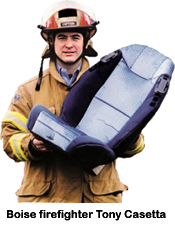![]()

NEWS
ROOM
ITD
News
USDOT News
Associated Press
News
Link
TRANSPORTATION
ORGANIZATIONS
State
of Idaho
ITD Home Page
AAMVA
AASHTO
USDOT
Federal Highways
TRIP
TRB
NTSB
NHTSA
EMPLOYEE
RESOURCES
PERSI
Group Insurance
Regence BlueShield
EAP
Idaho DHR
FINANCIAL
RESOURCES
IDAHY
Credit Union
Pocahy
Credit Union
|
Campaign
urges parents, caregivers to use
These watchwords are at the heart of an ITD Office of Highway
Safety campaign launched this month. The awareness campaign
urges parents and caregivers to use the right safety seats
for children, and about the need for booster seats. “Keeping children safe on the road means putting them in the right safety restraint at the right age,” said Josephine O’Connor, Idaho Office of Highway Safety (IOHS). While most infants and toddlers ride in the appropriate safety seat, 90 percent of children who should be in booster seats are not, according to the National Highway Traffic Safety Administration (NHTSA). “Booster seats bridge the gap between child safety seats and seat belts for kids under 80 pounds,” O’Connor said. “There’s a critical time when kids have outgrown safety seats but are still too small to use seat belts alone. They need the protection of booster seats.” A booster seat elevates a child so a seat belt can fit correctly. Most seat belts are designed to protect an average–sized adult male. Young children using only seat belts are at risk of injuries to the abdomen and spine, and are four times more likely to suffer a serious head injury in a crash than if secured in a booster seat. IOHS recommends booster seats for children who are 4 to 8 years old, unless they are at least 4 feet 9 inches tall. Low-back booster seats that securely position the lap and shoulder belts properly are available for less than $20. “Many people believe that if they follow a law requiring child safety seats for kids 4 years or younger and weighing less than 40 pounds, or instead use the seat belt alone, they’re adequately protecting their child,” O’Connor said. “Unfortunately, that’s simply not true. Children tend to put the shoulder belt behind their backs because it’s uncomfortable – but doing so is illegal. It is the responsibility and obligation of the driver to make certain the child is safely restrained, whether in a safety seat or a booster seat.” Use of booster seats is required in 22 states and the District of Columbia. Idaho does not require booster seats, although neighboring states, including Wyoming, Montana, Nevada, Washington and Oregon do.
|
||||||||
|
Return to Transporter Main Page
|
 “Give
your child’s safety a boost.”
“Give
your child’s safety a boost.” As
part of that effort, child safety seat information is front
and center on the ITD web site, making safety tips a mouse
click away. The campaign features Boise firefighter Captain
Tony Casetta and ads appear on television, radio and billboards
around Idaho.
As
part of that effort, child safety seat information is front
and center on the ITD web site, making safety tips a mouse
click away. The campaign features Boise firefighter Captain
Tony Casetta and ads appear on television, radio and billboards
around Idaho.
